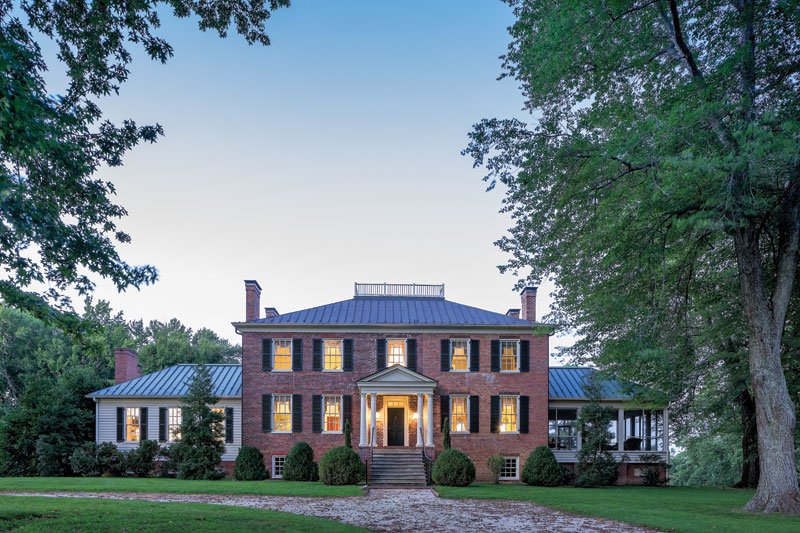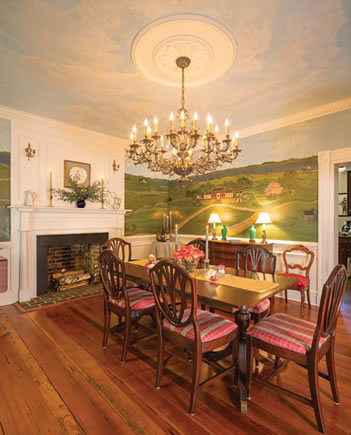By Joan Tupponce
Ben Lomond is one of the oldest houses in Essex County, but the grand estate has many tales yet to tell.

Craig Shirley smiles as he walks down the more than 200-year-old stairway in his Essex County home, Ben Lomond, and thinks of all the generations of children that have ridden down its bannister or bounded down the stairs on Christmas mornings.
As he reaches the bottom, a crevice in the first baluster draws his attention. “With many old houses, the builders carved a fissure in the first baluster,” says the noted author and historian, fingering the oddity. “They then capped it and sometimes nailed a coin there. When the mortgage was paid off, the property owners burned the receipt and placed the ashes in the hole and then resealed it.”
Shirley loves learning about these types of historic tidbits, especially here at Ben Lomond. He and his wife Zorine purchased the 18th-century house with attendant 64 acres and moved in late last summer. They had been searching for a historic home in Virginia for about six years after living in the Washington, D.C., area since 1982. “We looked at about 50 different houses and put in offers on two,” says Shirley, 59. After both deals failed to materialize for various reasons, they began their search again.
Zorine says the couple knew Ben Lomond was the right property the minute they saw the year 1730 chiseled on the two brick gates at the entrance to the long driveway. “This house is nearly 50 years older than the Declaration of Independence. It is one of the oldest houses in Essex County.”

Paying homage to the home’s origins, stately portraits of Judge Muscoe Garnett, the first judge of Essex County and a member of the Virginia House of Delegates, and his wife, Sarah Gatewood Garnett, hang on the foyer walls. The couple moved into the 9,000-square-foot home in 1838 and made major renovations, adding an east wing to balance the symmetry of the original west wing.
Shirley’s enthusiasm for the heritage of the property is spurred by his passion for history. A native of Syracuse, New York, he graduated from Springfield College in Massachusetts with a major in history. But his abiding interest in American history and politics dates back to his childhood sitting around the dinner table with his parents and siblings in their Cape Cod-style home.
Shirley’s father was a city firefighter; his mother, a homemaker. “On their honeymoon my parents went to all the historic sites in Virginia,” Shirley says. “Their house was a monument to American colonial history.”
Their home was filled with historical artifacts, books and prints, as well as small-framed pictures of field commanders from the Revolutionary War, all crafted by Shirley’s father when he was young. Shirley now has the pictures, which hang at Ben Lomond.
Dinners at home, says the affable Shirley, were always full of lively conversation. During the week meals were more casual, but on Sundays the family gathered in the formal dining room, where they discussed everything from history and politics to race relations and current events. “My earliest memory of sitting around the table was my father asking all three of us who we wanted for president, Richard Nixon or John F. Kennedy,” says Shirley.
His brother and sister said Nixon but Shirley answered Kennedy because “he was better looking.” His politically conservative father laughed and remarked that a lot of people would probably choose Kennedy for the same reason.
Shirley’s first brush with politics was at the age of eight, when he went door to door campaigning for Barry Goldwater during the presidential election. However, it wasn’t until August 1976, while slinging hash at a seafood restaurant in Cape Cod, Massachusetts, that he realized his future was in politics, and not in a schoolroom teaching history as he had planned after graduation.
Shirley stopped working for a moment to watch the television as Ronald Reagan made his concession speech to Gerald Ford during the Republican convention. “I thought, ‘This is great. I have to get involved,’” he says. When he got back to college, he began volunteering for the Gerald Ford camp. “I was working hard, registering voters, acting as a youth spokesman.”
He was only 19 when the state Republican chairman called him and asked if the two could meet in Boston for lunch. “I went there in my beat-up old car and my Sears & Roebuck suit,” Shirley recalls. The chairman was direct, telling the teen that he had a clear knack for the business. “That really changed the course of my life. At one point he said, ‘You should pursue this as a career.’”
That was the beginning of a calling that has spanned four decades. Early on, Shirley served as press secretary for Northern Virginia during John Dalton’s campaign for governor. “He was a great Republican,” Shirley says of Dalton, Virginia’s 63rd governor.
He additionally served as a member of the staff of the Republican National Committee, the political arm of the Reagan White House, and later as the director of communications for the National Conservative Political Action Committee. He also ran an independent campaign in support of Reagan’s nomination in 1980. After opening his own firm, Craig Shirley & Associates, which is now Shirley & Banister Public Affairs, in 1984, he represented corporations, associations, opinion leaders, political organizations, book publishers, authors and foreign governments.
Shirley left the day-to-day duties of that job to become a full-time author, a career he didn’t envision for himself until one of his clients, Thomas Nelson Publishing, suggested it. Shirley had mentioned to the publisher that no one had written a book about the 1976 presidential campaign and how it changed politics. “I called four or five different people and no one expressed interest in writing it,” says Shirley, adding that he called the publisher back and “he said why don’t you write it? That changed the course of my life.”
Today Shirley has published four books. They include Rendezvous with Destiny: Ronald Reagan and the Campaign that Changed America (2011) and Reagan’s Revolution: The Untold story of the Campaign that Started It All (2005). His third book on Reagan, Last Act: the Final Years and Emerging Legacy of Ronald Reagan, will be released Oct. 4. “I am working on three books [including a biography of Newt Gingrich, Citizen Newt, which will be published next spring] and I have a list of 28 more books [of varying subject matter] I want to write,” he laughs. When the couple moved into Ben Lomond, Shirley designated two rooms in the basement as his writing den and library. The couple plans to convert a screened porch on the first floor into a new den and library in the future. For now, Shirley is happy with the current setup, which includes a wall-sized hand-hewn antique pine cabinet held together with pegs. “It has no nails,” he says. “It was probably part of the original structure.”
He admits he has an obsession with books, a fact his wife backs up. “I can’t bear to part with them,” he says. “I still have my college books.”
Books, including many on history and art, are scattered about the house. The formal living room also holds a Hudson River School painting from the 1820s that includes a tree falling down as well as two sailboats in the distance.
“That makes the painting unique,” explains Shirley. Most of the painters from that movement painted landscapes that “often didn’t have any human activity.”
The massive cedar doors that separate the living room from the ladies’ parlor have their own story to share. “They were once pocket doors and someone threw them away,” says Zorine. “Then someone found them and bought them back and painted them as hinge doors.”
The former servant quarters and carriage room on the second floor have been turned into bedrooms, one of which houses an oversized antique sleigh bed. They are two of the seven bedrooms in the home. “This house has gone through feast and famine,” Shirley says as he heads toward a narrow staircase leading to the widow’s walk on the top floor. “I think about how many searching women walked the widow’s walk, looking for an approaching husband, coming back from the sea, coming back from war, who might never return.”
An admirer of George Washington, Shirley named two of the bedrooms in the home George and Martha in honor of the former president and his wife. His family’s relatives include the Shirleys of Virginia and Massachusetts, one of whom had ties to the first president. “The first territorial governor of Massachusetts was William Shirley, who knew George Washington well. I am also related to Henry Shirley for whom Route 95 is named,” says Shirley.
Ben Lomond—named for its resemblance to the Ben Lomond area in the Scottish Highlands—is about 40 minutes away from Trickle Down Point, the couple’s vacation home on the Rappahannock River in Lancaster County. The river property is a place where the couple can relax and share visits with their four children—Matthew, 29, Andrew, 27, Taylor, 22 and Mitchell, 18—whenever they can. (All of the children have their father’s love of lacrosse, a game he played in high school and college. Shirley also founded the Ft. Hunt Youth Lacrosse League and coached there for 14 years.)
The couple also owns a house on Union Farm, one of the original five farms of George Washington’s estate in Fairfax County, along with a circa 1700 building in Old Town Alexandria housing Shirley’s office and a third-floor apartment used by the couple when they visit D.C.
But it’s Ben Lomond that will serve as the couple’s home base, a place where history continues to live. “When I walk the halls of Ben Lomond I think of the judges, congressmen, senators, Civil War veterans and World War I and II veterans who have passed through the same hall,” says Shirley. “Also the writers, scholars, carpenters, doctors, brick masons, historians, a cross section of America. Also slaves and freed slaves. We don’t feel ghosts at Ben Lomond but we feel their occurrence. They will never go unremembered or unremarked.
“Zorine and I feel a responsibility to take care of—to be good custodians of and pass on lovingly—Ben Lomond. We are simply passing through history, but Ben Lomond is history.”
